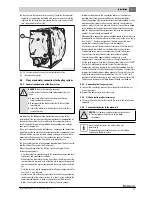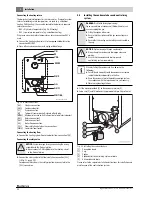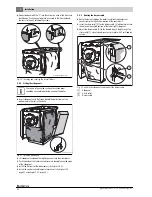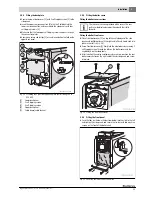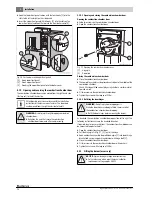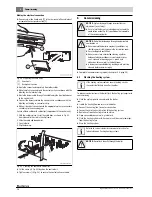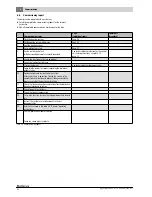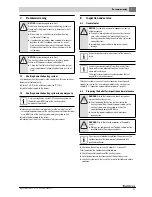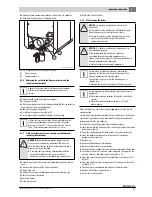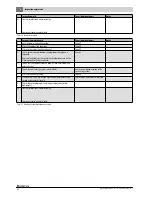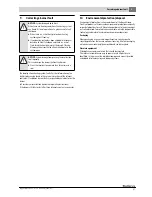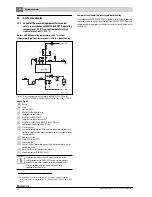
6
Commissioning
Logano plus SB325 – 6 720 806 328 (2013/07)
29
6.2
Filling the heating system
The fill and top-up water quality must comply with the specifications in
the operator's log supplied. For more information, see “Heating water
quality” chapter 3.9 on page 12.
The pH value of the heating water increases after the heating system has
been filled. After 3 – 6 months (initial service) check whether the pH
value of the heating water has settled down.
▶ Adjust the pre-charge pressure of the expansion vessel to the
required pressure (only for sealed unvented systems).
▶ Open the mixing and shut-off valves on the heating water side.
▶ Fill the heating system slowly using an on-site filling device and
observe the pressure gauge whilst doing so.
▶ Vent the heating system via the radiator air vent valves.
If the water pressure drops as a result of venting the system:
▶ Top up the system with water.
▶ Carry out a leak test in accordance with locally applicable regulations.
▶ After the tightness test, reinstate all components that were taken out
of operation.
▶ Ensure that all pressure, control and safety equipment is functioning
correctly.
Once the boiler has been tested for tightness and no leaks have been
found:
▶ Set the correct operating pressure.
▶ Close the automatic air vent valve.
6.3
Preparing the heating system for operation
Observe the following points during commissioning:
▶ Purge the gas supply in line with current legislation.
▶ Before commissioning, vent the heating system via the ventilation
facilities provided for this purpose.
▶ Check that the cleaning cover on the flue gas collector is closed.
▶ Check that the combustion chamber door is securely closed.
▶ Check that the safety equipment (e.g. safety valve, minimum and
maximum pressure limiters, high limit safety cut-out) is functioning.
▶ Check that the required operating pressure has been built.
▶ Check the flange connections and other connections for tightness.
▶ Check the control unit connections and temperature sensor
positions.
▶ Fill the condensate siphon.
6.4
Commissioning the control unit and burner
By commissioning the control unit you automatically commission the
burner as well. The burner can then be started by the control unit. For
further information, see the installation instructions of the relevant
control unit or burner (
chapter 3.9, page 12).
▶ Use the control unit to commission the boiler.
▶ Set the control unit parameters
▶ Observe the commissioning times (
chapter 6.1, page 28)
▶ Complete the commissioning report in the technical documentation
of the burner.
6.5
Setting control unit parameters
The controller settings listed in Tab. 14 apply to the Logamatic 4321
and 4322 control units.
For further information on setting the control unit, see chapter 3 from
page 11.
NOTICE:
System damage due to temperature stresses!
▶ Only fill the heating system when cold (the flow
temperature must not exceed 40 °C).
▶ During operation, only fill the heating system via the
fill valve in the heating system pipework (return).
CAUTION:
Health risk through contaminated drinking
water.
▶ Observe all country-specific regulations and
standards regarding the prevention of drinking water
contamination. In Europe, observe standard
EN 1717.
Open the automatic air vent valve only briefly for venting.
NOTICE:
Ensure the filling and top up water meets the
requirements outlined in the water treatment
instructions supplied with the boiler
NOTICE:
Excessive system water top up can lead to
boiler damage. Always monitor the system top up water
consumption. Repair any leaks immediately.
According to standards, a leakage rate on the flue gas
side of 2 % of the flue gas mass flow rate is permissible.
To ensure that the Logamatic operates correctly if
burner type "dual fuel burner" is selected, connect a
floating contact to terminal "ES" to change the fuel type.
Burner
Control unit setting
Burner type for fuel
Burner type
to be selected
Burner
Gas
Single fuel burner
Modulating
Modulating
2-stage
2-stage
Tab. 14 Controller settings for Logamatic 4321 and 4322 control units





